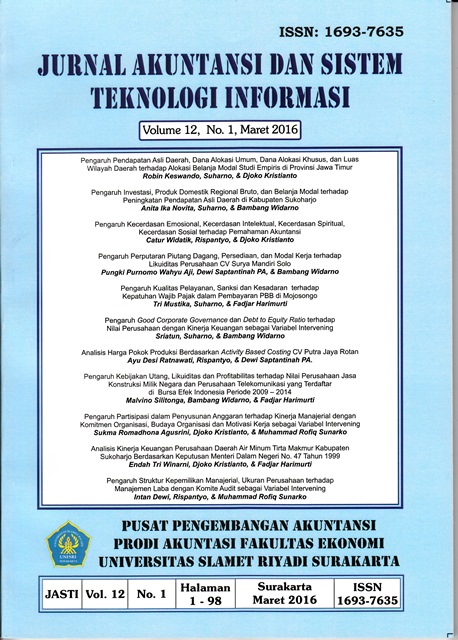PENGARUH PERPUTARAN PIUTANG DAGANG, PERSEDIAAN, DAN MODAL KERJA TERHADAP LIKUIDITAS PERUSAHAAN CV SURYA MANDIRI SOLO
Abstract
The survival of the company based on the assessment of financial performance can be seen from the level of liquidity of the company itself. Liquidity became a reference point as a company's ability to meet short-term obligations. Factors affecting the liquidity trade receivables turnover is, supplies, and working capital. The purpose of this study: 1) to determine the influence of Trade Receivables turnover of liquidity the company's. 2) to determine the effect of merchandise inventory turnover of liquidity in the company's. 3) to determine the effect of rotation of the working capital to the liquidity of the company's. Research methods method using case studies, the type of data used quantitative and qualitative data, the source data used are secondary data. Method of data collection used documentation. Technique of data analysis used the classic test assumptions, some linear regression analysis, t-test, F and the coefficients of determination. In Conclusion: 1) analysis results obtained with t values arithmetic amounts to 4893 with a value of 0.001 probability Ho is then 0.05 < rejected means that there is a significant positive influence on the company's trade receivables turnover liquidity CV Surya Mandiri Solo 2) analysis results obtained with t values arithmetic amounts to 4645 to the value of the probability of 0.002 < 0.05 Ho then rejected means that there is a positive and significant impact on the liquidity of the company's inventory turnover CV Surya Mandiri Solo. 3) the results of the analysis of the obtained values of t-0750-value probability 0475 > 0.05 then Ho received means no significant negative impact on working capital turnover in corporate liquidity in CV Surya Mandiri Solo.
Keywords: account turnover inventory items, working capital turnover turn over of accounts receivable, liquidity
Downloads
Published
Issue
Section
License
Authors who publish this journal agree to the following terms:
- Authors retain copyright and grant the journal right of first publication with the work simultaneously licensed under a Creative Commons Attribution License that allows others to share the work with an acknowledgement of the work's authorship and initial publication in this journal.
- Authors can separately make additional contractual arrangements for non-exclusive distribution published by the journal (e.g., publish it in a book), with an acknowledgement of its initial publication in this journal.
- Authors are allowed and encouraged to send their work via online (e.g., in the institutional repositories or their website) after published by the journal.










